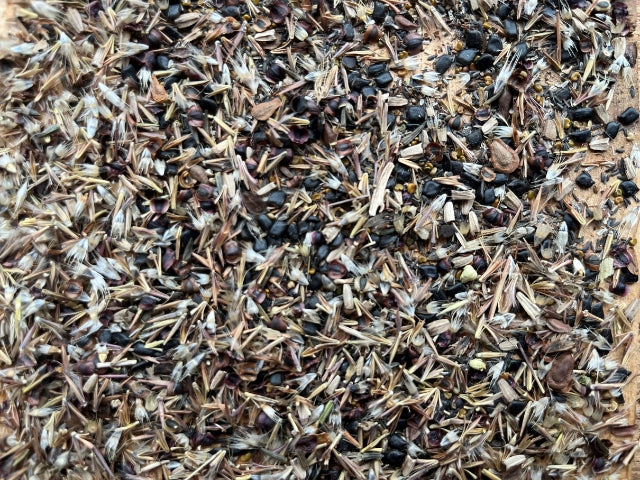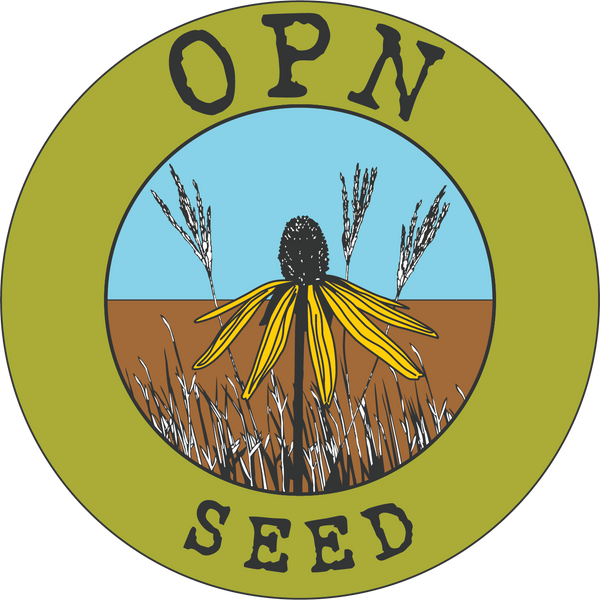
A Look Into Seed Mix Design
Share
Our native seed mixes are designed to make your decision to create a native plant community an easy one. We take numerous factors into account before a seed mix hits our website. Let's dig into what we look at during the design process.
My Native Plants Bring All The Pollinators (And More!) To The Yard
First, we identify what we are trying to attract. Many mixes are designed for attracting pollinators in general, but sometimes there is a more focused target like bees, butterflies, hummingbirds and songbirds. In that case, we specifically pick native wildflower and grass species that provide the most benefit.
Our Ohio Pollinator Oasis Seed Mix was designed with the Ohio State Beekeepers Association to be a high flowering, wildflower only seed mix that provides blooms spring through fall once established.
Butterfly/Hummingbird Mix contains three different types of milkweed for migrating Monarch butterflies and tubular wildflowers to attract hummingbirds.
The Song Bird Seed Mix was designed to provide seed sources for song birds late fall into early winter when the native wildflowers species in the mix are done blooming.
Reach For The Sky
Next, we think about height during the design process. Short growing native species are typically between 3 and 5 feet tall. Tall growing native plants can grow taller than 6 feet! We have seed mixes that specifically focus on height - short, tall or both combined.
Our Native Short Grass and Wildflower Seed Mix is one of our most popular mixes, not only because the heights of these plants will be on the shorter side, but it works in a wide variety of growing conditions.
The Native Tall Grass and Wildflower Seed Mix is the taller sibling to the above mix. Contains warm season native tall grasses and native wildflowers that usually get between 5 to 7 feet tall. This mix is great for creating a sunny meadow that is low maintenance once established.
Want a little bit of everything? We designed the Mixed Height Native Grass and Wildflower Seed Mix to be a truly diverse planting once established.
What Do I Plant On My....?
Site characteristics are important to make sure the native plants selected will grow in the targeted habitat. Sunlight, soil hydrology and specific application purposes are some of these characteristics and we take these into account during the design process.
Our Woodland Edge Mix doesn't just work for woodland edges, but also for those areas that receive lower light levels during the course of the day. The species specifically selected for this mix will usually grow in areas that receive at least 4 hours of sunlight a day.
Slopes can be tricky to plant on, so our Slope Pollinator Mix was designed with some species that quickly establish to stabilize the soil while perennial native plants take the time needed to take root.
Septic Fields need plants that don't have hardy taproots, so the species in this mix were selected to not interfere with the system once established. The plants in this mix prefer dry soil to draw moisture away from the system to make it more efficient.
Bringing It All Together
Now that we understand what we want to attract, how tall we want it to be and where it will be installed, we can put it all together. Balancing the mix by seed count is very important. Balancing can be for grass to wildflower ratio, annual vs. perennial species and between the individual species to get growth throughout the growing season. Native seeds also have a wide range of seed sizes. Understanding these differences to make sure that the mix has the right amount of every species is critical.
The difference between our Native Short Grass and Wildflower Seed Mix and our Econo Native Short Meadow Mix is a perfect example of grass to wildflower ratio. They are similar mixes in that the species are almost exactly the same, but they are different in the percent of grass seed to wildflower seed in the overall make-up. Native grasses are typically less expensive, so the Econo version has a higher grass ratio to keep the cost down.
For most of our mixes, we include annual wildflowers for first growing season color. Native meadows and prairies take approximately 3 years to mature from seed, so having some first year color is nice. Striking the right balance of annuals to provide color, but not dominate the the mix by seed count is important. Plus, they can help suppress undesirable plant growth!
We spend a lot of time including perennial species that will flower and give the landscape growth throughout the growing season. Perennial species make up a high percentage of our seed mixes and provide a beautiful aesthetic and habitat during spring, summer and fall. These are the species that you're seeding to create a long term solution to put native plants back into the landscape. Keep in mind, this may take 3 years, but it will be worth it.
We are mindful of costs as well. Some species cost more than others. Taking all the other factors into account and balancing the cost can be challenging. We offer a variety of price points on our mixes to meet any budget.
Too Long, Didn't Read
To summarize, we basically try and make the selection process as easy as possible for you. Got a slope? Want to plant for your honeybees? We got you! We do the work to make sure you're getting the most balanced, high quality native seed mix possible for your site that will meet your objectives. And in the instance that our standard mixes don't fit your site, custom seed mixes are available.
